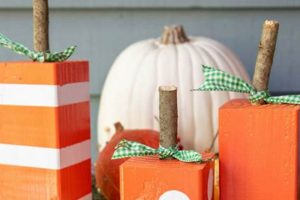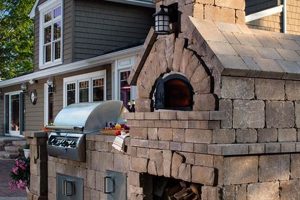Handcrafted wooden supports designed to hold shelving are a practical and aesthetically versatile option for home organization and decor. These supports, typically constructed from various wood types, offer a visible means of securing shelves to a wall or other vertical surface, providing a stable platform for holding items. For instance, a homeowner might create several such supports from reclaimed lumber to display books or decorative objects in a living room.
The utilization of these supports provides numerous advantages, including cost-effectiveness compared to commercially manufactured options and the ability to customize dimensions and style to perfectly complement an interior space. Historically, employing handcrafted supports dates back centuries, reflecting a tradition of resourcefulness and personalized craftsmanship in home furnishings. The choice to construct such supports allows for control over the materials used, promoting sustainable practices when utilizing recycled or sustainably sourced wood.
The subsequent sections will explore diverse design considerations for creating these supports, suitable wood selection processes, essential tools and techniques required for construction, and finishing options that enhance both durability and visual appeal.
Construction Insights for Custom Shelf Supports
The following provides essential guidance for fabricating durable and visually appealing wooden shelf supports. Careful consideration of these points will contribute to a successful outcome.
Tip 1: Material Selection is Crucial: Prioritize hardwoods, such as oak, maple, or walnut, for enhanced strength and resistance to warping. Softwoods like pine may be suitable for lighter loads or aesthetic applications, but require careful bracing and thicker dimensions.
Tip 2: Accurate Measurement Ensures Stability: Precisely measure the desired shelf depth and load-bearing requirements before cutting any wood. Consistent dimensions across all supports are vital for a level and stable shelf installation. Employ a level and measuring tape for meticulous accuracy.
Tip 3: Joint Construction Impacts Strength: Mortise and tenon joints, while requiring more skill, offer superior strength compared to simple butt joints. Alternatively, reinforced butt joints using screws and wood glue, or the addition of metal fasteners, can provide adequate support for lighter loads.
Tip 4: Proper Angling Enhances Support: When designing angled supports, calculate the optimal angle to effectively distribute weight. Trigonometry principles can be applied to determine the correct angle based on shelf depth and anticipated load.
Tip 5: Secure Mounting is Essential: Select appropriate mounting hardware based on the wall material (e.g., drywall, plaster, brick). Use wall anchors designed for the specific load and wall type to prevent pull-out. Ensure screws are long enough to penetrate the wall studs for maximum stability.
Tip 6: Finish Application Protects the Wood: Apply a protective finish, such as varnish, lacquer, or polyurethane, to seal the wood and prevent moisture damage. Multiple coats may be necessary for adequate protection, particularly in humid environments. Sanding between coats ensures a smooth and durable finish.
Tip 7: Pilot Holes Prevent Splitting: Drill pilot holes before driving screws to prevent the wood from splitting, particularly when working with hardwoods. The pilot hole diameter should be slightly smaller than the screw’s core diameter.
Adherence to these guidelines will result in shelf supports that are both structurally sound and visually appealing, providing a long-lasting and aesthetically pleasing storage solution.
The subsequent section will delve into common errors encountered during the fabrication process and propose preventative measures to ensure a high-quality final product.
1. Wood Selection
The choice of wood fundamentally influences the structural integrity and aesthetic character of handcrafted shelf supports. Wood selection directly affects the support’s load-bearing capacity, resistance to warping or cracking, and overall lifespan. For instance, utilizing a dense hardwood, such as oak or maple, is often preferred for applications requiring significant weight support, such as bookshelves or pantry shelving. Conversely, a softwood like pine, while more cost-effective and easier to work with, is more appropriate for lighter-duty applications like displaying decorative items or supporting lightweight plants. Incorrect wood selection may result in structural failure, leading to shelf collapse and potential damage or injury.
The species of wood also dictates the finishing options available and the resulting visual aesthetic. Hardwoods generally accept stains and finishes more evenly, allowing for a wider range of color and sheen choices. Softwoods, due to their porous nature, may require more preparation and specialized finishes to achieve a desired look. Reclaimed wood, another viable option, offers a unique aesthetic with pre-existing character, but careful inspection is required to ensure structural soundness and freedom from pests or decay. Failure to consider grain pattern can result in a weaker bracket, where stress forces the wood to split parallel to the grain.
Consequently, deliberate wood selection is not merely a cosmetic consideration, but a crucial engineering decision. It balances structural demands, aesthetic preferences, and budgetary constraints. The proper understanding of wood propertiesdensity, grain structure, moisture contentis paramount for achieving a durable, visually appealing, and functionally reliable shelf support system. This foundational choice directly determines the success or failure of the entire shelving project.
2. Joint Strength
The load-bearing capacity and long-term stability of handcrafted wooden shelf supports are fundamentally dependent on the strength of the joints employed in their construction. A robust joint prevents racking, sagging, and eventual failure, ensuring the reliable performance of the shelving system.
- Mortise and Tenon Joints
This joint type, characterized by a projecting tenon that fits precisely into a mortise, or hole, is renowned for its exceptional strength and resistance to shear forces. Commonly used in furniture making and timber framing, a mortise and tenon joint provides a mechanical interlock that significantly enhances the structural integrity of the support. An example is seen in heavy-duty bookshelves where substantial weight is anticipated. This type of joint resists the separation of joined parts.
- Dovetail Joints
Dovetail joints, distinguished by their interlocking, wedge-shaped tenons, offer exceptional tensile strength and resistance to pulling forces. These are frequently employed in drawer construction and can be adapted for shelf supports where a high degree of resistance to separation is required. A well-executed dovetail joint resists pulling or leverage forces.
- Reinforced Butt Joints
While simple to execute, butt joints, where two pieces of wood are joined end-to-end or edge-to-edge, require reinforcement to achieve adequate strength for shelf support applications. Screws, dowels, or metal fasteners, in conjunction with wood glue, can significantly enhance the load-bearing capacity of a butt joint. An example would be a shelf that is designed for light items only where a stronger joint would be considered as overengineering.
- Pocket Hole Joints
Pocket hole joinery offers a quick and efficient method for creating strong and stable joints. Angled screws are driven into pre-drilled pocket holes, drawing the two pieces of wood tightly together. This technique is well-suited for assembling shelf supports where speed and ease of construction are priorities, though it may not offer the same level of aesthetic appeal as traditional joinery methods. This creates a hidden fixing that can be visually appealing.
The selection of an appropriate jointing technique is crucial for ensuring the durability and functionality of handcrafted shelf supports. Factors such as the anticipated load, the type of wood used, and the desired aesthetic should all be carefully considered when choosing a suitable jointing method. The strength of these joints directly correlates to the safety and longevity of any shelving system constructed.
3. Load Capacity
The maximum weight a handcrafted wooden shelf support can safely bear is its load capacity, a critical factor in design and construction. Selecting inappropriate wood or utilizing weak joint construction has a direct and detrimental impact, potentially leading to structural failure and the collapse of the shelf. Consequently, determining the intended use of the shelf, and thus the anticipated weight it will hold, dictates every decision made during the creation of the supports.
Accurately estimating load capacity involves consideration of several variables. The wood species, dimensions of the supports, type of joinery, and method of attachment to the wall all play significant roles. For instance, a bracket constructed from a dense hardwood like oak and employing mortise and tenon joints, secured with heavy-duty fasteners to wall studs, will exhibit a considerably higher load capacity than one made from softwood and relying on simple butt joints anchored only to drywall. Neglecting this understanding has serious consequences. A shelf intended to hold heavy books, but supported by inadequate brackets, is prone to collapse, resulting in damage to the books and potential injury. Conversely, over-engineering the supports for a light load increases material costs and labor without providing a commensurate benefit.
Therefore, a thorough assessment of load capacity is paramount when undertaking a shelf support project. Calculating the anticipated weight, selecting appropriate materials and construction techniques, and implementing a safety margin are essential steps. This ensures the supports fulfill their intended function reliably and safely over an extended period. An overly cautious approach involving testing with increasing weight, is preferable to risking instability and possible failure.
4. Wall Anchors
The reliable performance of shelf supports constructed from wood is inextricably linked to the proper selection and installation of wall anchors. These fasteners mediate the transfer of weight from the shelf and its contents to the wall structure, and are therefore critical components. The use of inappropriate or inadequately installed wall anchors represents a common point of failure, leading to sagging, instability, and potentially complete detachment of the shelf. For instance, attempting to mount a heavy bookshelf solely with screws driven into drywall, without utilizing appropriate anchors, will predictably result in failure as the drywall crumbles under the load. The direct causal relationship underscores the importance of understanding anchor types and their intended applications.
Various types of wall anchors cater to different wall materials and load requirements. Toggle bolts, expansion anchors, and molly bolts are designed to provide secure holding power in drywall or plaster, while concrete screws or expansion anchors are necessary for masonry walls. Selecting the correct anchor type is predicated on accurately assessing the wall material and the anticipated weight load. Furthermore, proper installation techniques are paramount. Drilling pilot holes of the correct size, ensuring anchors are fully engaged, and avoiding over-tightening are all essential steps to prevent damage to the wall or the anchor itself. Consider, for example, a scenario where a solid wood shelf is used to support several potted plants. Utilizing plastic anchors designed for lightweight picture frames would prove inadequate, while a set of properly installed toggle bolts would provide the necessary stability and weight-bearing capacity.
In summary, the stability and longevity of wooden shelf supports are directly contingent upon the proper selection and installation of wall anchors. A thorough understanding of anchor types, wall materials, and load requirements is essential for ensuring a safe and reliable shelving system. Neglecting this critical aspect risks compromising the structural integrity of the supports and jeopardizing the items placed upon the shelf. Therefore, wall anchors are not merely accessories, but integral components of a successful and safe DIY shelving project.
5. Angle Accuracy
The precise angle incorporated into the design and construction of wooden shelf supports significantly impacts their load-bearing capacity and overall stability. Deviations from intended angles introduce stress concentrations and uneven weight distribution, compromising the structural integrity of the support. A shelf support designed with a 45-degree angle intended to distribute weight evenly across its length, if fabricated with a 40-degree or 50-degree angle instead, will exhibit reduced strength and an increased risk of failure. This is especially crucial in designs where the shelf weight is not directly above the vertical wall mounting point.
Angle accuracy is also paramount for ensuring the shelf remains level and aesthetically pleasing. Even slight angular inaccuracies in multiple supports result in a visibly tilted shelf, detracting from its functionality and appearance. In a scenario where multiple supports are utilized for a single long shelf, a consistent angular deviation of even one degree per support will compound, leading to a significant and noticeable slope across the shelf’s span. Ensuring precise angular measurements and cuts during construction is therefore essential. Tools such as protractors, miter saws with digital angle finders, and accurate levels are critical for achieving the necessary precision.
In summary, angle accuracy is not merely a cosmetic consideration in handcrafted wooden shelf supports, but a fundamental engineering requirement. Deviation from the intended angle negatively affects load capacity, stability, and visual appeal. Meticulous attention to angular precision during design and construction is thus indispensable for creating a durable, functional, and aesthetically satisfying shelving system. Ignoring accurate angles can result in structural failures or unsightly installations.
6. Finish Quality
The quality of the finish applied to handcrafted wooden shelf supports significantly influences their longevity, aesthetic appeal, and resistance to environmental factors. A well-executed finish not only enhances the natural beauty of the wood but also provides a protective barrier against moisture, scratches, and ultraviolet (UV) radiation, directly impacting the support’s long-term performance.
- Protection Against Moisture
Wood is inherently susceptible to moisture absorption, which can lead to swelling, warping, and ultimately, structural failure. A high-quality finish, such as varnish or polyurethane, forms a water-resistant layer, preventing moisture penetration and minimizing the risk of dimensional changes. Consider, for example, shelf supports in a bathroom setting, where exposure to high humidity and occasional water splashes necessitates a robust, moisture-resistant finish.
- Resistance to Scratches and Abrasions
Shelf supports are prone to accidental scratches and abrasions from items placed on or near the shelves. A durable finish, such as a catalyzed lacquer or epoxy resin, provides a hard, protective surface that resists scratching and abrasion, maintaining the support’s aesthetic appearance over time. This is particularly important in high-traffic areas or where the shelves are used to store heavy or abrasive objects. The application of several coats ensures an adequate thickness to withstand wear.
- Enhancement of Aesthetic Appeal
The finish plays a crucial role in enhancing the visual appeal of the wooden shelf supports. Stains, paints, and clear coats can be used to achieve a variety of looks, from highlighting the natural grain pattern of the wood to creating a contemporary, minimalist aesthetic. A properly applied finish provides a smooth, even surface that accentuates the wood’s beauty and complements the overall design of the shelving system. Meticulous sanding between coats is crucial for achieving a flawless final appearance.
- Prevention of UV Damage
Exposure to sunlight can cause wood to fade, discolor, or even degrade over time. Finishes containing UV inhibitors, such as certain spar varnishes or exterior-grade paints, help protect the wood from the damaging effects of UV radiation, extending its lifespan and preserving its original color. This is particularly important for shelf supports located near windows or in areas with high sun exposure. A specialized UV finish mitigates solar degradation.
In conclusion, the finish applied to wooden shelf supports is not merely a cosmetic detail, but a critical factor influencing their durability, functionality, and aesthetic longevity. Selecting an appropriate finish and applying it with meticulous care is essential for ensuring that the supports provide reliable and visually appealing service for years to come. Choosing the right finish helps ensure that the shelf supports withstand daily usage and various environmental conditions.
7. Design Harmony
The successful integration of handcrafted wooden shelf supports within a given space relies heavily on achieving design harmony. This concept extends beyond mere aesthetic appeal, encompassing a cohesive blend of form, function, and the existing architectural style. Disharmony, where the shelf supports clash with the surrounding environment, diminishes the visual impact and can render the shelving system ineffective, regardless of its structural integrity. For instance, rustic, rough-hewn supports, while structurally sound, would appear incongruous in a sleek, modern interior dominated by minimalist design principles and metallic accents. Conversely, delicate, ornate supports would be visually lost within a room characterized by bold, industrial elements. Design harmony is critical when building and placement of “diy wood brackets for shelves”.
Achieving design harmony necessitates a careful consideration of several factors. The wood species, finish, shape, and size of the supports must complement the existing color palette, material textures, and architectural details of the room. Furthermore, the chosen style should align with the intended function of the shelving. Supports designed for a formal library would likely differ significantly from those intended for a casual kitchen pantry. Practical application might involve selecting a dark, rich stain for supports in a traditional study, mirroring the existing woodwork, while opting for a light, painted finish for supports in a brightly lit children’s playroom. Successful implementation of this concept elevates the shelving from a purely functional element to an integral component of the room’s overall design aesthetic.
In summary, design harmony is a crucial, often overlooked aspect of creating handcrafted wooden shelf supports. It demands a deliberate and thoughtful approach, considering the interplay between the supports and their surrounding environment. By prioritizing design coherence, it ensures that the shelving system not only serves its intended purpose but also enhances the visual appeal and overall ambiance of the space. Challenges include balancing personal preferences with broader design principles, but the resulting visual synergy is well worth the effort. The design of brackets can range from basic and functional to artistically created.
Frequently Asked Questions
This section addresses common inquiries regarding the design, construction, and application of wooden shelf supports. The information aims to provide clarity and guidance for successful implementation.
Question 1: What wood species are most suitable for constructing load-bearing shelf supports?
Hardwoods, such as oak, maple, and walnut, offer superior strength and resistance to bending, making them ideal for applications requiring significant weight capacity. Softwoods, like pine, may be adequate for lighter loads, but necessitate larger dimensions and potentially reinforced construction.
Question 2: What jointing techniques provide the strongest and most durable connections for shelf supports?
Mortise and tenon joints are renowned for their exceptional strength and resistance to shear forces. Dovetail joints offer superior tensile strength, particularly useful where resistance to pulling forces is required. Reinforced butt joints, employing screws and adhesive, can provide adequate strength for lighter loads.
Question 3: How does one accurately calculate the load capacity of a handcrafted shelf support?
Load capacity calculation involves consideration of wood species, support dimensions, joint type, and wall attachment method. Consulting engineering resources and utilizing safety factors are essential for ensuring a safe and reliable design. Overestimation of anticipated loads is advisable.
Question 4: What types of wall anchors are appropriate for securing shelf supports to different wall materials?
Toggle bolts, expansion anchors, and molly bolts provide secure holding power in drywall or plaster. Concrete screws or expansion anchors are necessary for masonry walls. Selecting anchors rated for the anticipated load and wall type is crucial.
Question 5: How can one minimize the risk of wood splitting during screw installation?
Drilling pilot holes with a diameter slightly smaller than the screw’s core diameter is essential. This reduces stress on the wood fibers and minimizes the likelihood of splitting, particularly when working with hardwoods. Lubricating the screws can further reduce friction.
Question 6: What are the best practices for applying a protective finish to wooden shelf supports?
Surface preparation, including sanding and cleaning, is paramount. Applying multiple thin coats of varnish, lacquer, or polyurethane provides optimal protection against moisture and scratches. Sanding lightly between coats ensures a smooth and durable finish. Utilizing a finish with UV inhibitors is beneficial for supports exposed to sunlight.
Adherence to these principles ensures the creation of structurally sound and aesthetically pleasing shelf supports.
The subsequent section will explore potential design variations.
DIY Wood Brackets for Shelves
This exploration has illuminated the critical factors involved in crafting wooden shelf supports. From material selection and joint construction to load capacity assessment, wall anchor selection, angle accuracy, finish quality, and design harmony, each element contributes significantly to the structural integrity, longevity, and aesthetic integration of the final product. Meticulous attention to detail throughout the design and construction process is paramount for achieving a reliable and visually appealing shelving system. DIY wood brackets for shelves can be a challenging experience, but a rewarding experience.
The principles outlined herein provide a foundation for informed decision-making, enabling the creation of shelving solutions that meet specific functional requirements and aesthetic preferences. Continued adherence to sound engineering practices and a commitment to quality craftsmanship will ensure the enduring utility and visual appeal of these handcrafted elements. Success in this domain stems from the merging of technical skill and artistic vision, culminating in storage solutions that enhance their environment.







